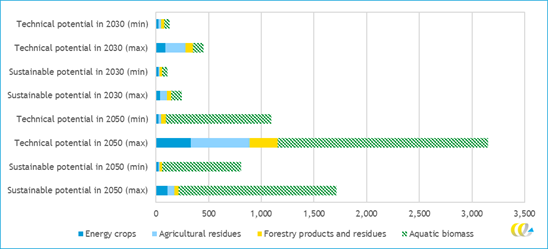Bioenergy global potential: current information

The maximum sustainable global bioenergy potential in 2050 is almost three times higher than the global supply of primary energy in 2015. Global bioenergy production in 2050 can be increased more than 35 times from the current level. Estimates of global (world) bioenergy potential for 2030 and 2050 for four categories of biomass with division into sustainable and technical potentials are presented. For each of the four categories, the smallest and largest values taken from different studies are presented.
The global potential of aquatic biomass for 2030 has not been identified in the literature. Many researchers claim that the production of aquatic biomass will not be profitable in 2030.
- As can be seen, the maximum sustainable global bioenergy potential exceeds 2000 EJ in 2050 (with aquatic biomass). For comparison: the global supply of primary energy in 2015 was 571 EJ, and the contribution of biomass to global energy consumption was 50 EJ. Thus, global energy production from biomass in 2050 can be increased more than 35 times.
- Second, the global potential of bioenergy could increase sharply eightfold between 2030 and 2050.
- Third, the estimated sustainable potential of bioenergy is about half of the technical potential. Excluding aquatic biomass, the sustainable bioenergy potential is approximately 40% of the technical potential in 2030 and 20% in 2050.
- Fourth, aquatic biomass can play an important role in 2050 and reduce the relative contribution of terrestrial biomass (energy crops, agricultural residues, and forestry products and residues) from 55-80% in 2030 to 5-35% in 2050. If we consider only the sustainable potential, the share of terrestrial biomass will be approximately 60% in 2030 and 15% in 2050.
According to the materials: Availability and costs of liquefied bio- and synthetic methane. March 2020.


